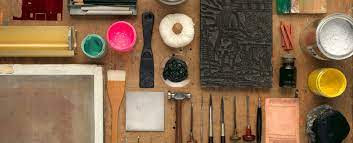Printmaking
Printmaking is the process of making artworks by printing, normally on paper. Except in the case of monotyping, the process is capable of producing multiples of the same piece, which is called a print. Each print is considered an original, as opposed to a copy. The reasoning behind this is that the print is not a reproduction of another work of art in a different medium — for instance, a painting — but rather an image designed from inception as a print. An individual print is also referred to as an impression. Prints are created from a single original surface, known technically as a matrix. Common types of matrices include: plates of metal, usually copper or zinc for engraving or etching; stone, used for lithography; blocks of wood for woodcuts, linoleum for linocuts and fabric in the case of screen-printing. But there are many other kinds, discussed below. Multiple nearly identical prints can be called an edition.
In modern times each print is often signed and numbered forming a "limited edition." Prints may also be published in book form, as artist’s books. A single print could be the product of one or multiple techniques.
The teaching staff are augmented by technical associates, who are also artists in their own right.
In addition to staffing the well-equipped workshops they offer one to one technical support and deliver practical workshops such as this painting workshop.


